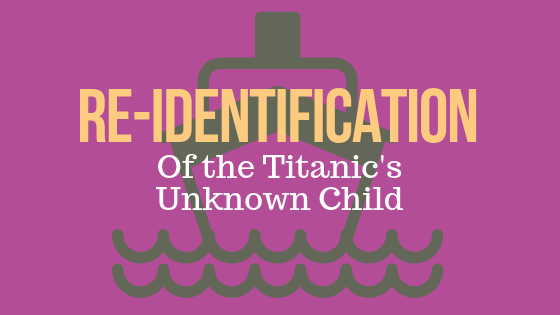On April 15, 1912, the Royal Mail Ship Titanic sank after striking an iceberg. Only 712 of the 2209 passengers survived. Within days of the disaster, the Mackay-Bennett was dispatched to recover the victims, one of which was a boy estimated to be 2 or 3 years of age. Efforts to identify the boy were in vain, although there was some evidence to suggest that the child was Gösta Leonard Pålsson, a 2-year-old Swedish boy who was washed overboard shortly before the Titanic sank. However, when no one identified or claimed the boy’s body, he was buried in Halifax, Nova Scotia with a headstone that was dedicated “to the memory of an unknown child”. The boy would have remained unknown too except that one of the families requested an exhumation and examination of the boy’s remains almost 90 years later.
Written by: Terri Sundquist, PRomega
In May of 2001, the Pålsson family requested that the remains be exhumed so that DNA testing could be performed to try to identify definitively the small body found floating in the icy Atlantic. Unfortunately, there was very little left to test: Only a 6cm bone fragment and three teeth were recovered from the grave, and those were described as “poorly preserved”.
The likelihood that nuclear DNA analysis could reveal the boy’s identity was low enough that forensic scientists decided not to pursue that approach. Nuclear DNA analysis has an amazing power of discrimination, but each cell only has one copy of nuclear DNA. When a set of remains is poorly preserved, it can be difficult to isolate enough nuclear DNA of sufficient integrity to perform the tests. Fortunately, there was a more promising approach: mitochondrial DNA. In addition to a single copy of nuclear DNA, each cell has hundreds of copies of mitochondrial DNA, which is passed down through the maternal lineage unchanged except for rare mutations. Like nuclear DNA, mitochondrial DNA has regions of polymorphic sequences that are useful in DNA-based identification. These DNA regions, dubbed hypervariable (HV) regions, often allow informative DNA analysis when nuclear DNA does not. These sequences would eventually help scientists assign an identity to the remains by matching the boy’s mtDNA sequences with those of his maternal relatives.
In the 2001, shortly after the remains were exhumed, mtDNA analysis of the HV1 region was performed using DNA isolated from the child’s remains and a number of maternal relatives of young male children who perished when the Titanic sank. Based on the results, scientists determined that the remains could belong to only one of two young male passengers: 13-month-old Eino Panula from Finland or 19-month-old Sidney Goodwin from England. However, the mtDNA sequences were similar enough that scientists could not conclusively distinguish between the two boys. As another means of identification, an odontological exam was performed, and the degree of tooth development was found to be consistent with a child between 9 and 15 months of age. Based on this information, the child was identified as Eino Panula in 2004 (1).
However, there was still uncertainty, in part because the mtDNA sequences were consistent with both children and because the shoes of the unknown child, which were preserved in the Maritime Museum of the Atlantic in Halifax, were thought to be too large for 13-month-old Eino Panula. Three years later, in 2007, the case was reopened to perform additional tests to quell the uncertainty. In this more recent study (2), scientists analyzed additional mtDNA sequences and found differences in the HV2 sequences, differences that enabled a more conclusive identification. Results of both HV1 and HV2 analyses allowed scientists to say, with 98.81% certainty, that the remains belonged to Sidney Goodwin, not Eino Panula.
Thus, almost 100 years after the maritime disaster, DNA provided the answer that all other means could not. While these results did not provide closure for the Pålsson family as hoped, the Goodwin family finally knew the fate of young Sidney.
References
- Titley, K.C. et al. (2004) The Titanic disaster: Dentistry’s role in the identification of an “unknown child”. J. Can. Dent. Assoc. 70, 24–8.
- Just, R.S. et al. (2010) Titanic‘s unknown child: The critical role of the mitochondrial DNA coding region in a re-identification effort. Forensic Sci. Int. Genet. In press, available online 2 April 2010.


